Abstract
Since maize, peanut, and cotton are economically valuable crops in the southeast United States, their yield amount changes in a future climate are attention-grabbing statistics demanded by associated stakeholders and policymakers. The Crop System Modeling—Decision Support System for Agrotechnology Transfer (CSM-DSSAT) models of maize, peanut, and cotton are, respectively, driven by the North American Regional Climate Change Assessment Program (NARCCAP) Phase II regional climate models to estimate current (1971–2000) and future (2041–2070) crop yield amounts. In particular, the future weather/climate data are based on the Special Report on Emission Scenarios (SRES) A2 emissions scenario. The NARCCAP realizations show on average that there will be large temperature increases (~2.7 °C) and minor rainfall decreases (~−0.10 mm/day) with pattern shifts in the southeast United States. With these future climate projections, the overall future crop yield amounts appear to be reduced under rainfed conditions. A better estimate of future crop yield amounts might be achievable by utilizing the so-called weighted ensemble method. It is proposed that the reduced crop yield amounts in the future could be mitigated by altering the currently adopted local planting dates without any irrigation support.
1. Introduction
In order to assess the impacts of weather/climate on agricultural production in the southeast United States, the North American Regional Climate Change Assessment Program (NARCCAP) Phase I multi-model regional climate models were employed as a driver in the state-of-art Crop System Modeling—Decision Support System for Agrotechnology Transfer (CSM-DSSAT) crop models to estimate three crop (maize, peanut, and cotton) yields for the period of 1981–2003 in our previous study [1]. It was shown that downscaling is an inevitable step before using any coarse-scale climate model forecasts in dynamical crop models and crop yield amount estimations could be improved by using weighted multi-model ensemble methods. While the benefit of downscaling was intensively examined, future crop yield projections were not covered in Shin et al. [1].
Hence, the authors are mainly considering in the current study how climate change is expected to affect agriculture in the southeast United States. Agriculture is a major industry in the southeast United States and it is a large contributor to total annual United States agricultural production. The estimated total value of cotton, maize, and peanut for Alabama, Georgia, and Florida in 2019 was $2.55 billion US dollars [2]. In general, crop yield amount increases as temperature increases, but just until some threshold temperature is reached. As an example, peanut yield has been proven to be negatively affected by temperature increases above a threshold value at an ambient carbon dioxide level. From 32/22 (maximum/minimum temperatures) to 36/26, 40/30, and 44/34 °C, crop yields progressively decrease by 14%, 59%, and 90% [3]. Individual farmers and consumers should be aware that crop productions might be affected by projected climate changes. A significant increase in temperatures and shifts in rainfall patterns could be detrimental to crop yields [4,5,6,7] in the southeast United States [8].
Since downscaling is necessary to adjust coarse resolution output of climate reanalysis or model simulations to account for unresolved processes at crop scales, which can have significant influence on yield simulations of dynamic crop models, the NARCCAP Phase II regional climate multi-model dataset [9,10] is utilized to drive the DSSAT crop models for 30 year-long current and future climate simulations/projections. The NARCCAP is a large collaborative effort to downscale the World Climate Research Programme Phase 3 of the Coupled Model Intercomparison Project (WCRP CMIP3) [11] climate models using six participating regional climate models. Although a more recent downscaling effort has been introduced using the CMIP5, such as NA-CORDEX (North America—Coordinated Regional Downscaling Experiment) [12], it is not used in the current study for consistency with our previous study [1]. While there is not a clear consensus about climate change uncertainties, it is nonetheless worthwhile to investigate possible climate change scenarios on agricultural production. Since maize, peanut, and cotton are economically valuable crops in the southeast United States, there is a high demand for any information on how their yield amount might change in a future climate [13].
The main objectives of this paper are (a) to project the potential effects of climate change on crops cultivated in the southeast United States, (b) to achieve a more reliable crop yield projection compared to the commonly-used regular ensemble mean projection, and (c) to explore the suitability of adaptation planning to cope with the projected effects of climate change. This study is conducted to help guide us in analyzing possible adaptation strategies to sustain agricultural production in the southeast United States. Although there are a few publications using point-based crop models to test the effect of shifting planting dates as a measure to cope with climate change effects [14,15,16,17], virtually no studies have been made using a regional climate model.
The paper is organized as follows: the observed weather/climate and the NARCCAP data are described in Section 2. The details of the utilized crop models are presented in Section 3. Section 4 shows current and future crop yield simulations/projections, in addition to the assessment of a weighted ensemble method, and an adaptive practice for crop production in the southeast United States. The discussion and conclusions follow in Section 5 and Section 6, respectively.
2. Weather/Climate Data
2.1. Observed Data
The study area consists of three states (Alabama, Georgia, and Florida) in the southeast United States. Currently, this region has some of the warmest conditions in the United States. The annual rainfall amounts range from 1100 to 1400 mm, with the highest amounts occurring along the Gulf of Mexico and south Florida. The Cooperative Observer Network (COOP) based observed daily weather records (maximum and minimum temperatures, and precipitation) for the period of 1971–2000 are provided by the Florida Climate Center. The provided data are on a regularly gridded mesh (~20 × 20 km, roughly resolving the county scale). Since no incoming solar radiation data are recorded in the COOP data set, the method of Bristow and Campbell [18] is used to estimate the solar radiation. A total of 1171 weather grid points are available in our study domain. These observed weather records are the reference inputs used in the maize, peanut, and cotton models to simulate observed-weather-driven crop yield amounts.
2.2. NARCCAP Phase II
The NARCCAP Phase II dataset is selected because its regional climate models (RCMs) are temporally and spatially appropriate scales to drive dynamical crop models as shown in our previous study [1]. It engages six RCMs driven by four CMIP3 models forced with the Special Report on Emission Scenarios (SRES) A2 scenario. In its experimental design, each RCM is coupled to one of two selections of CMIP3 models, which are atmosphere-ocean global climate models (AOGCMs). The RCMs are run at a 50 km horizontal resolution. In this study, the Phase II dataset is collected and statistically further downscaled to our weather grid points over the southeast United States for use in crop model simulations. Table 1 provides information on the NARCCAP Phase II RCM and AOGCM combination data set used in this study. Ten combinations of the NARCCAP multi-models are used among the total 12 available combinations. This is due to the late release of two combinations (EH and MH).

Table 1.
The NARCCAP Phase II models. Models utilized in this paper are shaded with abbreviation.
3. Crop Model
Crop models have been widely used to project potential impacts of climate change on agriculture and to search for adaptation options by stakeholders and policy makers. White et al. [30] reviewed a total of 221 research papers in their study. The main topic of all reviewed papers was about the use of crop simulation models to examine various aspects of agriculture being affected by climate change. The review of prior work is beyond the scope of this paper.
The current study utilizes the CSM-DSSAT model [31,32] to simulate crop yield amounts in current (1971–2000) and future (2041–2070) climates in the southeast United States. The experimental periods are selected due to the NARCCAP data availability. The CSM-DSSAT integrates the effects of crop genotype, soil profiles, weather data, and management options into a crop model. Maize, peanut, and cotton are selected due to their economic value in this region. While the CERES-Maize is utilized for corn, the CROPGRO is selected for peanut and cotton within the DSSAT crop model. The crop model uses maximum and minimum temperature, rainfall, and incoming solar radiation from growing season-long daily weather data. It simulates plant growth and development processes on a daily basis in a specific location, from planting date to maturity date. As a result, the impact of weather, soils, and management decisions on crop yield can be well estimated.
The geospatial simulation platform (GEM) [33] is employed to perform the crop simulations for all grid point locations of the study region. This study uses hypothetical crop coverage on the regularly gridded mesh and adopts representative crop management practices that reflect current and planned agricultural land use by farmers. Physical and chemical data for the dominant soil are obtained from the United States Department of Agriculture-Natural Resources Conservation Service soil surveys of the three states and corresponding counties [34]. The soil data are reanalyzed following the procedure shown in Romero et al. [35] and soil profile description is created for a grid with a resolution of 20 km × 20 km. Physical and chemical properties included are soil texture, bulk density, soil depth, soil color, organic carbon, organic nitrogen, pH, and cation exchange capacity. During the reanalysis procedure, the hydraulic coefficients (saturation, field capacity, and wilting point) are estimated. Additional data associated with the soil profile description and required for the crop model are added. They are runoff curve number, soil fertility factor, root growth factor, and carbon/nitrogen ratio. Identical initial soil moisture conditions (set at 75%) are assumed in all simulations; however, all simulations are started 2 months prior to the planting date to let the soil modules of the crop model stabilize soil moisture at the time of seedling emergence according to the environmental conditions. Following two previous associated studies [35,36], the soil fertility factor is set to 0.90 for all soil profiles. The root growth factor is set as 1.00 for the top soil (0.15 m) and it is never allowed to fall below 0.1 all the way to the bottom of the soil profile. Residues in the soil profile are set to 1000 kg ha−1 at 1% of nitrogen. No fertilization is applied. Plant density is set to 20.8 seeds m2 with row spacing set to 0.91 m. The planting date for each year is 1 April for maize and cotton, and 25 April for peanut. These dates correspond to the middle of the range of planting dates reported by USDA-NASS [37]. Therefore, the weather/climate input is the only parameter that can change crop yields in a given year at a given location in our experiments. The authors assumed in this study that all crops could potentially be sowed and grown at our defined 1171 grid point locations. However, crop models do not grow crops in urban areas.
4. Results
4.1. Crop Yield Amounts in Current Climate
The observed weather/climate records are first used to drive the DSSAT maize, peanut, and cotton crop models. Figure 1a shows 30-yr averaged (1971–2000) maize yields under rainfed conditions. The area averaged maize yield dry matter is 7801 kg ha−1. Crop yield amounts are relatively low in southern Georgia. This might be due to the soil types around this area. This area corresponds to the Coastal Plain in Georgia, where soils are not very fertile because of their high content of sand and highly meteorized clay minerals, as well as for their poor drainage conditions. No yields are found around the metropolitan areas (e.g., around Atlanta). Although these hypothetical crop yield distributions cannot be verified with any existing observed crop yield data (see Section 5), the authors assume, in this study, that these observed-weather-driven crop yields can be used as good proxies for the observed counterparts. The authors want only weather/climate to be a driving factor, not other things that might affect crop production in the real world.
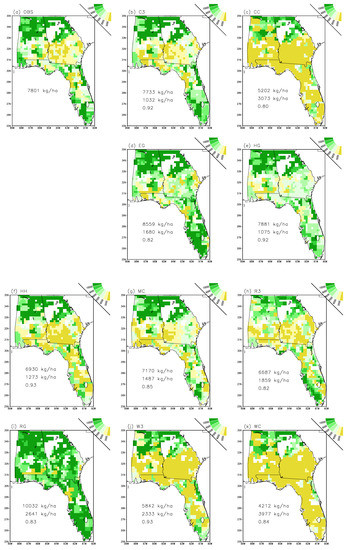
Figure 1.
Simulated (a) observed-weather-driven and (b–k) ten NARCCAP regional-model-driven maize dry matter yields (30-yr average, 1971–2000) under rainfed conditions. Unit is of kg ha−1. In each panel, the first value is area averaged yield amount, the second one RMSE, and the third one spatial correlation with the observed-weather-driven yield.
The corresponding ten NARCCAP Phase II regional-model-driven maize dry matter yields under rainfed conditions are shown in Figure 1b–k. There is a large yield variability among the individual models. The model performance of ten individual members is presented in terms of area-averaged yield amount, spatial root mean square error (RMSE), and spatial correlation coefficient (SCORR). Although the models C3 (RMSE = 1032 kg ha−1, SCORR = 0.92) and HH (RMSE = 1273 kg ha−1, SCORR = 0.93) have relatively higher skill scores for maize, other model members show comparable skill levels as well. These model performance statistics for the current climate can be used to judge the individual model reliability for future climate. The good spatial correlation statistics verify that the dynamical downscaling can capture fine-scale spatial features of weather/climate patterns, which is essential information for the crop yield simulations [1].
The performance metrics (RSME and SCORR) for peanut and cotton, in addition to maize, are summarized in Table 2. While the C3 performs better than other members for maize in terms of RMSE, the HH performs better for peanut and cotton. The HG (HH) shows the best score for peanut (maize and cotton) in terms of SCORR. If only these metrics are considered, it can be concluded that the performance of the HRM3 models driven by GFDL and/or HadCM3 are more reliable than other models in the current (1971–2000) NARCCAP runs. However, more trustworthy skill levels can be assessed by considering other factors in addition (e.g., crop types, high moment metrics, and/or climate models).

Table 2.
Spatial RMSE and SCORR (spatial correlation) for 30-yr average (1971–2000) crop yield under rainfed conditions. Gray cells denote the best statistics among the analyzed group.
4.2. Future Climate Projection
The NARCCAP Phase II data provide future model climates, in addition to current model climates. Hence, it is straightforward to compute future climate change compared to the current climate. Figure 2 shows the ten-member ensemble average projected maximum and minimum temperatures and rainfall differences between future (2041–2070) and current (1971–2000) NARCCAP runs. While the area-averaged maximum (minimum) temperature difference is 2.96 °C (2.42 °C), the area-averaged rainfall difference is −0.10 mm/day. Since the NARCCAP future runs are based on the SRES A2 emissions scenario, this large temperature increase is an expected outcome. An overall reduction of rainfall amount and shift of the rainfall pattern are projected in the southeast United States. Climate differences of all ten member models are summarized in Table 3. It is clearly shown that there are differences in the projected climate change range: maximum temperature (1.56 to 3.92 °C), minimum temperature (1.71 to 3.37 °C), and rainfall (−0.50 to 0.55 mm/day). In particular, the projected rainfall variability is relatively large among the used models. Three (EG, HG, and HH) out of the ten models project rainfall increase especially around southern Georgia and northern Florida.

Figure 2.
Projected (a) maximum temperature, (b) minimum temperature, and (c) precipitation differences between future (year 2041–2070) and current (year 1971–2000) NARCCAP runs. All ten employed models are simply averaged. Area averaged values are shown.

Table 3.
Projected area-average maximum temperature, minimum temperature, and rainfall differences between future (2041–2070) and current (1971–2000) NARCCAP runs.
4.3. Crop Yield Amounts in Future Climate
Positive and negative impacts of climate change in crop production are projected to occur at different areas of the study region. Due to a projected temperature increase, the crop growing season length is projected to decrease in the future, by about 1 to 3 days. Water requirements are projected to increase mostly in counties located in Georgia and less in counties in Florida, probably due to differences in water balance components (precipitation, evapotranspiration, soil moisture, and runoff).
Figure 3 shows maize dry matter yield differences between future and current NARCCAP Phase II models. The future maize yield amounts from all models are decreased in terms of area-averaged values under rainfed conditions due to the increased temperature and reduced/shifted rainfall. They range from −336 to −2050 kg ha−1. However, the maize yield amounts from some models (C3, EG, HH, R3, and W3) are projected to increase in some localized areas possibly due to a better environmental condition for maize production even in a warmer climate. The ten simulated NARCCAP model-driven yield differences for peanut and cotton, in addition to maize, are summarized in Table 4. In general, the area-averaged yield amounts in the southeast United States are expected to be reduced for all crops and models in future climates, except for a few exceptions (EG for peanut; EG and R3 for cotton).
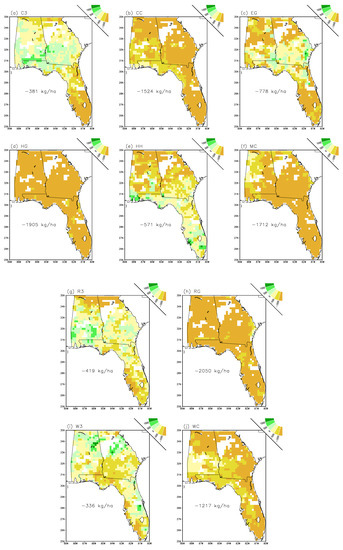
Figure 3.
Ten simulated NARCCAP regional-model-driven maize dry matter yield differences between future (2041–2070) and current (1971–2000) runs under rainfed conditions. Unit is of kg ha−1. Area-averaged values are shown.

Table 4.
Ten simulated NARCCAP regional-model-driven crop dry matter yield differences between future (2041–2070) and current (1971–2000) runs under rainfed conditions. Unit is of kg ha−1.
4.4. Weighted Ensemble
Many different regional climate scenarios can be realized by the NARCCAP Phase II multi-model dataset. A proper combination (or filtering) method can reduce the uncertainties of the climate projections. Multi-model ensemble approaches have been widely used to obtain a superior prediction from available weather and/or climate data [38,39,40]. These studies showed that a weighted ensemble method performed better than any individual model in their framework.
In this study, two ensemble averaging methods are adopted to combine the NARCCAP Phase II multi-model regional climate simulations/projections:
(a) Regular Ensemble (RE)
(b) Weighted Ensemble (WE)
where is the number of ensemble members, is a forecast by model i and the weights are normalized so that their sum is unity. For equally reliable models (i.e., conventional approach),. The WE differs from the RE in that different members are weighted based on prior statistics obtained during a training period before the forecast phase.
One way of defining the weights for the different models is to relate the weights to a skill score () of interest:
where is a scale parameter (if , become the RE; if, pick the best member; we used). For this study, the RMSEs for the NARCCAP runs in current climate (1971–2000; see Table 2) are used for . If the spatial pattern is considered to be a more important outcome, then SCORR can be used instead. For the current study, the weights are not varying in space to simplify the method. If many (possibly more than 30 to 50) 30-year-long climate data sets are available, spatially varying weights can be computed such as the WE method used in Shin et al. [40].
Figure 4 shows multi-model ensembles of maize yield differences between future and current NARCCAP runs. While the RE is the simple composite of the ten members from Figure 3, the WE is computed using Equation (2) where different weights are assigned to each model based on the performance of NARCCAP runs in the current climate. The RE projects a reduced area-averaged maize yield amount (−1091 kg ha−1) in the future. This reduced yield amount can be improved by the WE method to achieve a more trustworthy projection. According to our chosen WE method, the area-averaged future maize yield amount is −1066 kg ha−1. Although the adjusted amount is relatively small (Figure 4c; 25 kg ha−1), the WE is expected to be a better quantitative estimate of future maize yield reduction. If a longer data set is available, we could consider having spatially varying weights and possibly produce a better future crop yield change estimation. Similarly, multi-model ensembles of peanut and cotton yield differences between future and current are shown in Figure 5 and Figure 6, respectively.
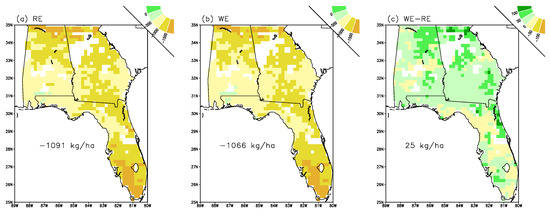
Figure 4.
Multi-model ensembles of maize dry matter yield differences between future and current NARCCAP runs from Figure 3; (a) the regular ensemble, (b) the weighted ensemble, and (c) their difference. Unit is of kg ha−1. Area averaged values are shown.
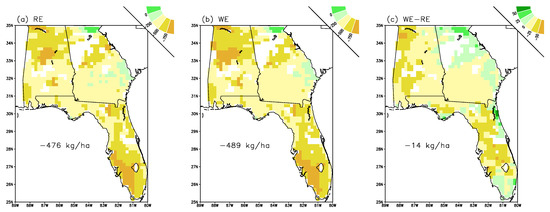
Figure 5.
As in Figure 4, but for peanut.
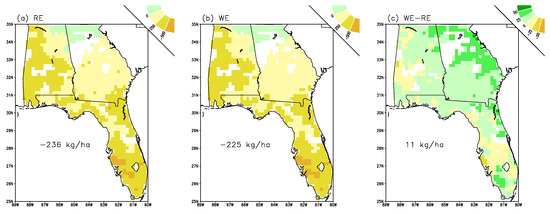
Figure 6.
As in Figure 4, but for cotton.
4.5. Adaptation Practice
Adaptation strategies, such as the selection of sowing date, changing hybrids and cultivars, adopting different fertilization, and conversion of agriculturally important non-irrigated to irrigated areas, were recommended as options to reduce the potential negative impact of climate warming. Adaptation is considered as a responsibility of farmers and agri-business decision-makers, and it is often considered a government policy response in agriculture to develop a climate change policy [41].
In the previous two subsections, it was found that the southeast United States might experience serious crop reduction in the future (2041–2070). How can we resolve or minimize this crop reduction problem? The increased temperature and reduced/shifted rainfall might be modulated by intensive use of irrigation systems. However, the cost of the irrigation system cannot be ignored. What is the most cost-effective way to minimize the crop reduction? Without irrigation support (i.e., no extra cost), simply altering the currently adopted planting dates can relieve the crop yield reduction in the future. The CSM-DSSAT crop models are re-implemented with six different planning dates (±14, ±28, and ±42 days). For the NARCCAP C3 model, an earlier planting date (−14 day) than the baseline planting date (1 April) can relieve the maize yield reduction problem in the southeast United States, except for south Florida (Figure 7). If the maize is planted +48 days later, the maize yield amount can be substantially increased in south Florida, as shown in Figure 7f. Figure 7 can provide stakeholders very useful information for their future adaptation planning. A similar pattern of crop yield changes is obtained from different models and crops (e.g., Figure 8 for peanut and Figure 9 for cotton). The most important lesson we learned is that altering the planting date (well-guided by specialists) might be the most cost-effective and easiest adaptation strategy to minimize the negative impact of upcoming climate change on economically valuable crops in the southeast United States.
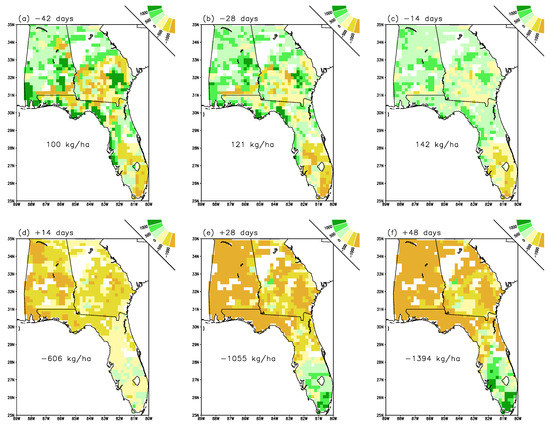
Figure 7.
Simulated NARCCAP C3 regional-model-driven future maize dry matter yield differences between six different planning dates (±14, ±28, and ±42 days) and the control planting date (1 April) under rainfed conditions. Unit is of kg ha−1. Area averaged values are shown.
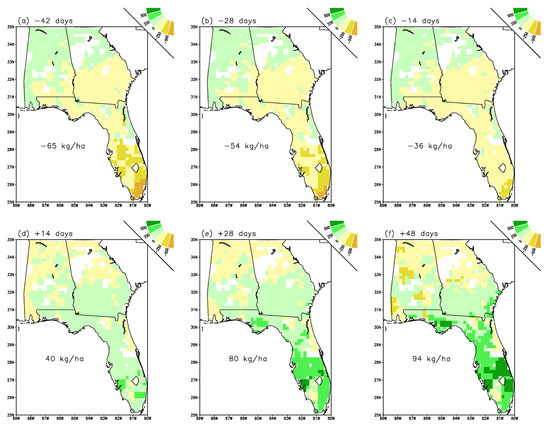
Figure 8.
As in Figure 7, but for peanut using the NARCCAP HH model. The control planting date is 25 April.
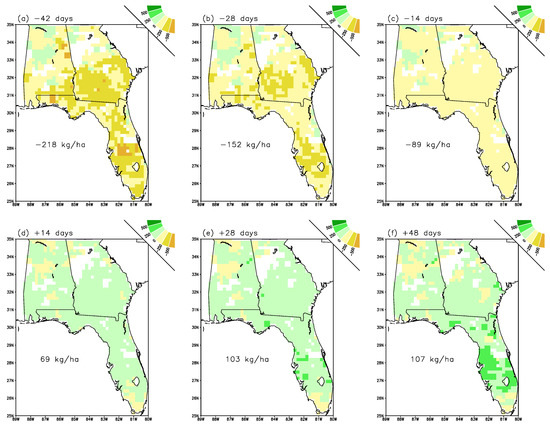
Figure 9.
As in Figure 7, but for cotton using the NARCCAP HH model.
5. Discussion
In this study, the authors did not use the NASS crop yield data in order to validate our crop model yield amounts in the current climate (1971–2000). It should be noted that the NASS provides county-level yield estimates. However, the NASS data, depending on crop varieties, are not available for the majority of our hypothetical 20 by 20 km grid cell locations. In addition, the NASS report includes the technology trend that is inherent in the data per se. Evolution in genetics, agrochemicals, machinery, etc. has made agriculture more efficient, increasing yields, which are not climate-related. It is possible to remove the technology trend from the NASS time series; but unfortunately, there are no standard, proven scientific methods to do that. This issue will add an unnecessary source of uncertainty in the analysis of the present paper since removing the technology trend is too subjective. In addition, the calibration and validation of the DSSAT crop model are out of the scope of this paper. The employed DSSAT model has been well-calibrated and validated by other scientists around the southeast United States [e.g., the southeastern Climate Consortium (SECC) group]. The crop models were calibrated using field experiments in the region, carried out by a private sector company that does not allow the disclosure of the experimental data or scientists to mention the source of the data for calibrating the model.
It should be acknowledged that the SRES A2 scenario and CMIP3 are dated. Not only have CMIP5 RCPs (Representative Concentration Pathways) been available for some time, but CMIP6 scenarios are forthcoming. However, the NARCCAP Phase II data were only recently available to scientific communities and have not been employed at all to evaluate the crop yield projections in the southeast United States. Hence, it is worthwhile to explore the value and/or usefulness of the data in crop models. It would be an interesting endeavor to investigate how using more updated scenarios (CMIP5 or CMIP6) might change our results relative to the output driven by CMIP3.
Crop yield estimations under rainfed conditions only were considered in the present study. In fact, the authors performed extra experiments to estimate crop yield amount using a full irrigation assumption. That is, water is supplied to the crops whenever the crops experience water stress. In order to present our results concisely and effectively, these results were not shown in this paper, but they could help estimate how much water irrigation is needed in a future climate. Related in-depth studies for hydrological practice with crop models can be found in Siad et al. [42] and López-Lambraño, et al. [43]. Furthermore, an economic analysis for the irrigation system can be performed using our results. The net present value (NPV) and the internal rate of return (IRR) can be used to measure the returns of the irrigation systems [44,45]. The NPV compares the discounted costs of a project with the discounted benefits. If the NPV of a project is negative, then costs are higher than benefits; consequently, the implementation of the project should be rejected. The IRR is the discount rate at which the NPV just equals zero. The IRR represents the average earning power of the money generated by the project over its lifetime. In practice, most policy and decisionmakers accept (reject) a project if the appropriate discount rate is less (greater) than the IRR [46,47].
To evaluate the economic impact of improving the projection of future regional crop yield at a farm level, the implementation of a Treatment Effect (TE) analysis can be used. TE is a project evaluation technique commonly used in economics [48]. In general terms, TE is measured by the difference in the total value of farm output (TVFO) between farmers using the improved climate-based farm management strategies (treated), and the incomes of farmers who did not (control). A quasi-experimental design can be used to estimate the economic impact of improving crop forecasting. Specifically, we can use hypothetical scenarios based on optimal farm management practices. In doing so, we can measure, at the optimum level of production, the value of improved climate information.
6. Conclusions
It is well documented that climate change and/or variability can influence agricultural yields and incomes. In this regard, climate information and projections offer a potential to tailor agricultural management to mitigate impacts of adverse conditions and to take advantage of favorable conditions. Thus, improved projections offer farmers a managerial tool to reduce the uncertainty of future events. The yield projection technique proposed in this paper offers a marginal improvement with respect to previous ones by reducing the deviation from the mean of yield projections. In doing so, we also reduce farmers’ perception of production risk based on future climatic conditions by decreasing the uncertainties of a cop model.
The NARCCAP Phase I regional climate models were mainly used in our previous study [1], where the importance of downscaling and the usefulness of a weighted ensemble for crop yield simulations were emphasized. However, the Phase I regional climate data do not include the future climate projections. Hence, the NARCCAP Phase II regional multi-model weather/climate data were utilized in this study to drive economically valuable maize, peanut, and cotton models to estimate current (1971–2000) and future (2041–2070) crop yield amounts in the southeast United States (Alabama, Georgia, and Florida). Ten combinations of the NARCCAP regional model data were employed to explore potential impacts of the SRES A2 emissions scenario-based future climate on agricultural production. The CSM-DSSAT model was utilized to simulate crop yield amounts. Maize, peanut, and cotton were selected due to their economic value in the southeast United States. While the CERES-Maize was used for maize, the CROPGRO was utilized for peanut and cotton within the DSSAT crop model system. The crop model uses maximum and minimum temperature, rainfall, and incoming solar radiation from growing season-long daily weather data.
The observed-weather-driven crop yields were first compared with ten NARCCAP regional-model-driven yields under rainfed conditions for the current (1979–2000) climate in order to assess the performance of the employed regional climate models in terms of RMSE and SCORR. There was a large yield variability among the individual models. The model performance statistics for the current climate were used to judge the individual model reliability for future climate. Since there will be substantial temperature increases and rainfall decreases/shifts in the future according to the NARCCAP projections, the crops could experience unfavorable environmental conditions to produce the current level of crop yield amount. It was presented that, on average, future maize, peanut, and cotton yield amounts were projected to be significantly decreased under rainfed conditions in our study domain. A weighted ensemble technique was used to provide a better estimate of future crop yield amounts driven by the NARCCAP data. In the weighted ensemble, different weights were assigned to each model based on the performance metrics of NARCCAP runs for the current climate. The weighted ensemble could be a better quantitative estimate of future crop yield reduction by intelligently combining the multi-model members. In order to reduce the potential negative impact of climate change, a suitable adaptive approach, altering the currently used planting date, was proposed to minimize the reduced crop yield problem in the future without relying on expensive irrigation support in the southeast United States.
Author Contributions
Conceptualization, D.W.S. and G.A.B.; methodology, D.W.S. and S.C.; software D.W.S., G.A.B. and C.C.R.; validation, D.W.S., S.C., G.A.B., B.-M.K. and K.-Y.K.; formal analysis, D.W.S., S.C., and G.A.B.; investigation, D.W.S. and B.-M.K.; resources, D.W.S. and K.-Y.K.; data curation, D.W.S., C.C.R., and B.-M.K.; writing—original draft preparation, D.W.S.; writing—review and editing, S.C., G.A.B., B.-M.K. and D.W.S.; visualization, D.W.S.; supervision, D.W.S.; project administration, D.W.S. and K.-Y.K.; funding acquisition, K.-Y.K. and D.W.S. All authors have read and agreed to the published version of the manuscript.
Funding
This research was funded by the USDA/NIFA grant 2011-00828 (EaSM Project) and the Korea Meteorological Administration Research and Development Program under Grant KMI2020-01310.
Acknowledgments
The views expressed in this paper are those of the authors and do not necessarily reflect the views of USDA and KMA, or any of its associated partners.
Conflicts of Interest
The authors declare no conflict of interest.
References
- Shin, D.W.; Baigorria, G.A.; Romero, C.C.; Cocke, S.; Oh, J.-H.; Kim, B.-M. Assessing crop yield simulations driven by the NARCCAP regional climate models in the southeast United States. J. Geophys. Res. Atmos. 2017, 122, 2549–2558. [Google Scholar] [CrossRef]
- USDA-NASS (United States Department of Agriculture—National Agricultural Statistics Service). 2019 Statistics by State. Available online: http://www.nass.usda.gov/Statistics_by_State/ (accessed on 9 September 2020).
- Prasad, P.V.V.; Boote, K.J.; Allen, H., Jr.; Thomas, J.M.G. Super-optimal temperatures are detrimental to peanut (Arachis hypogaea L.) reproductive processes and yield at both ambient and elevated carbon dioxide. Glob. Chang. Biol. 2003, 9, 1775–1787. [Google Scholar] [CrossRef]
- Gornall, J.; Betts, R.; Burke, E.; Clark, R.; Camp, J.; Willett, K.; Wiltshire, A. Implications of climate change for agricultural productivity in the early twenty-first century. Philos. Trans. R. Soc. B Biol. Sci. 2010, 365, 2973–2989. [Google Scholar] [CrossRef] [PubMed]
- Zhao, C.; Liu, B.; Piao, S.; Wang, X.; Lobell, D.B.; Huang, Y.; Huang, M.; Yao, Y.; Bassu, S.; Ciais, P.; et al. Temperature increase reduces global yields of major crops in four independent estimates. Proc. Natl. Acad. Sci. USA 2017, 114, 9326–9331. [Google Scholar] [CrossRef]
- Kukal, M.S.; Irmak, S. Climate-driven crop yield and yield variability and climate change impacts on the U.S. Great Plains agricultural production. Sci. Rep. 2018, 8, 3450. [Google Scholar] [CrossRef]
- Ray, D.K.; West, P.C.; Clark, M.; Gerber, J.S.; Prishchepov, A.V.; Chatterjee, S. Climate change has likely already affected global food production. PLoS ONE 2019, 14, e0217148. [Google Scholar] [CrossRef]
- Baigorria, G.A.; Jones, J.W.; O’Brien, J.J. Understanding rainfall spatial variability in the Southeast USA at different timescales. Int. J. Climatol. 2007, 27, 749–760. [Google Scholar] [CrossRef]
- Mearns, L.O.; Gutowski, W.J.; Jones, R.; Leung, L.-Y.; McGinnis, S.; Nunes, A.M.B.; Qian, Y. A regional climate change assessment program for North America. EOS 2009, 311–312. [Google Scholar] [CrossRef]
- Mearns, L.O.; Arritt, R.; Biner, S.; Bukovsky, M.S.; McGinnis, S.; Sain, S.; Caya, D.; Correia, J.; Flory, D.; Gutowski, W.; et al. The North American regional climate change assessment program overview of phase I results. Bull. Am. Meteorol. Soc. 2012, 93, 1337–1362. [Google Scholar] [CrossRef]
- Meehl, G.A.; Covey, C.; Delworth, T.; Latif, M.; McAvaney, B.; Mitchell, J.F.B.; Stouffer, R.J.; Taylor, K.E. The WCRP CMIP3 multimodel dataset. Bull. Am. Meteorol. Soc. 2007, 88, 1383–1394. [Google Scholar] [CrossRef]
- Bukovsky, M.; Gao, J.; Mearns, L.O.; O’Neill, B. The NA-CORDEX Dataset; NCAR Climate Data Gateway: Boulder, CO, USA, 2017. [Google Scholar]
- Mbow, H.O.; Reisinger, A.; Canadell, J.; O’Brien, P. Food Security. In Climate Change and Land: An IPCC special report on climate change, desertification, land degradation, sustainable land management, food security, and greenhouse gas fluxes in terrestrial ecosystems. Intergov. Panel Clim. Chang. 2019, 22, 58. [Google Scholar]
- Nouri, M.; Homaee, M.; Bannayan, M.; Hoogenboom, G. Towards shifting planting date as an adaptation practice for rainfed wheat response to climate change. Agric. Water Manag. 2017, 186, 108–119. [Google Scholar] [CrossRef]
- Dobor, L.; Zoltán, B.; Tomáš, H.; Tamás, A.; Tamás, S.; Nándor, F. Crop planting date matters: Estimation methods and effect on future yields. Agric. For. Meteorol. 2016, 223, 103–115. [Google Scholar] [CrossRef]
- Anwar, M.R.; Wang, B.; Liu, D.L.; Waters, C. Late planting has great potential to mitigate the effects of future climate change on Australian rain-fed cotton. Sci. Total Environ. 2020, 714, 136806. [Google Scholar] [CrossRef]
- Qian, B.; Zhang, X.; Smith, W.; Grant, B.; Jing, Q.; Cannon, A.J.; Neilsen, D.; McConkey, B.; Li, G.; Bonsal, B.; et al. Climate change impacts on Canadian yields of spring wheat, canola and maize for global warming levels of 1.5 °C, 2.0 °C, 2.5 °C and 3.0 °C. Environ. Res. Lett. 2019, 14, 074005. [Google Scholar] [CrossRef]
- Bristow, K.; Campbell, G. On the relationship between incoming solar radiation and daily maximum and minimum temperature. Agric. For. Meteorol. 1984, 31, 159–166. [Google Scholar] [CrossRef]
- Caya, D.; Laprise, R. A semi-Lagrangian semi-implicit regional climate model: The Canadian RCM. Mon. Weather Rev. 1999, 127, 341–362. [Google Scholar] [CrossRef]
- Juang, H.; Hong, S.; Kanamitsu, M. The NMC nested regional spectral model: An update. Bull. Am. Meteorol. Soc. 1997, 78, 2125–2143. [Google Scholar] [CrossRef]
- Jones, R.; Hassell, D.; Hudson, D.; Wilson, S.; Jenkins, G.; Mitchell, J. Generating High Resolution Climate Change Scenarios Using PRECIS; Met Office: Exeter, UK, 2003; p. 34.
- Grell, G.; Dudhia, J.; Stauffer, D.R. A Description of the Fifth Generation Penn State/NCAR Mesoscale Model (MM5); NCAR Tech. Note NCAR/TN-398; NCAR, Mesoscale and Microscale Meteorology Division: Boulder, CO, USA, 1993; p. 107. [Google Scholar]
- Giorgi, F.; Marinucci, M.R.; Bates, G.T. Development of a second-generation regional climate model (RegCM2). Part I: Boundary-layer and radiative transfer processes. Mon. Weather Rev. 1993, 121, 2794–2813. [Google Scholar] [CrossRef]
- Skamarock, W.C.; Klemp, J.B.; Dudhia, J.; Gill, D.O.; Barker, D.M.; Wang, W.; Powers, J.G. A Description of the Advanced Research WRF Version 2; NCAR Tech. Note NCAR/TN-468+STR; NCAR, Mesoscale and Microscale Meteorology Division: Boulder, CO, USA, 2005; p. 88. [Google Scholar]
- Collins, W.D.; Bitz, C.M.; Blackmon, M.L.; Bonan, G.B.; Bretherton, C.S.; Carton, J.A.; Chang, P.; Doney, S.C.; Hack, J.J.; Henderson, T.B.; et al. The Community Climate System Model: CCS3. J. Clim. 2006, 19, 2122–2143. [Google Scholar] [CrossRef]
- Flato, G.M. The Third Generation Coupled Global Climate Model (CGCM3). 2005. Available online: http://www.ec.gc.ca/ccmac-cccma/default.asp?n=1299529F-1 (accessed on 1 September 2019).
- GFDL GAMDT (The GFDL Global Model Development Team). The new GFDL global atmospheric and land model AM2-LM2: Evaluation with prescribed SST simulations. J. Clim. 2004, 17, 4641–4673. [Google Scholar] [CrossRef]
- Gordon, C.; Cooper, C.; Senior, C.A.; Banks, H.; Gregory, J.M.; Johns, T.C.; Mitchell, J.F.B.; Wood, R.A. The simulation of SST, sea ice extents and ocean heat transports in a version of the Hadley Centre coupled model without flux adjustments. Clim. Dyn. 2000, 16, 147–168. [Google Scholar] [CrossRef]
- Pope, V.D.; Gallani, M.L.; Rowntree, P.R.; Stratton, R.A. The impact of new physical parameterizations in the Hadley Centre climate model: HadAM3. Clim. Dyn. 2000, 16, 123–146. [Google Scholar] [CrossRef]
- White, J.W.; Hoogenboom, G.; Kimball, B.A.; Wall, G. Methodologies for simulating impacts of climate change on crop production. Field Crop. Res. 2011, 124, 357–368. [Google Scholar] [CrossRef]
- Jones, J.; Hoogenboom, G.; Porter, C.; Boote, K.; Batchelor, W.; Hunt, L.; Wilkens, P.; Singh, U.; Gijsman, A.; Ritchie, J. The DSSAT cropping system model. Eur. J. Agron. 2003, 18, 235–265. [Google Scholar] [CrossRef]
- Hoogenboom, G.; Jones, J.W.; Wilkens, P.W.; Porter, C.H.; Batchelor, W.D.; Hunt, L.A.; Boote, K.J.; Singh, U.; Uryasev, O.; Bowen, W.T.; et al. Decision Support System for Agrotechnology Transfer Version 4.0; University of Hawaii: Honolulu, HI, USA, 2004. [Google Scholar]
- Baigorria, G.A.; Romero, C.C. Assessment of erosion hotspots in a watershed: Integrating the WEPP model and FIS in a case study in the Peruvian Andes. Environ. Modeling Softw. 2007, 22, 1175–1183. [Google Scholar] [CrossRef]
- USDA-NRCS. 2015 Soil Surveys. Available online: http://www.nrcs.usda.gov/wps/portal /nrcs/soilsurvey/soils/survey/state/ (accessed on 15 March 2017).
- Romero, C.C.; Hoogenboom, G.; Baigorria, G.A.; Koo, J.; Gijsman, A.J.; Wood, S. Reanalysis of a global soil database for crop and environmental modeling. Environ. Model. Softw. 2012, 35, 163–170. [Google Scholar] [CrossRef]
- Ruane, A.C.; McDermid, S.; Rosenzweig, C.; Baigorria, G.A.; Jones, J.W.; Romero, C.C.; De Wayne, C. Carbon-Temperature-Water change analysis for peanut production under climate change: A prototype for the AgMIP Coordinated Climate-Crop modeling project (C3MP). Glob. Chang. Biol. 2014, 20, 394–407. [Google Scholar] [CrossRef] [PubMed]
- USDA-NASS. Field Crops. Usual planting and harvesting dates, Agricultural Handbook Number 628. 2010. Available online: http://usda.mannlib.cornell.edu/usda/current/planting-10-29-2010.pdf (accessed on 15 March 2017).
- Shin, D.W.; Krishnamurti, T.N. Short to medium-range superensemble precipitation forecasts using satellite products: 1. Deterministic forecasting. J. Geophy. Res. 2003, 108, 8383. [Google Scholar] [CrossRef]
- Kar, S.C.; Hovsepyan, A.; Park, C.K. Economic values of the APCN multi-model ensemble categorical seasonal predictions. Meteorol. Appl. 2006, 13, 267–277. [Google Scholar] [CrossRef]
- Shin, D.W.; Kang, S.-D.; Cocke, S.; Goo, T.-Y.; Kim, H.-D. Seasonal probability of precipitation forecasts using a weighted ensemble approach. Int. J. Climatol. 2008, 28, 1971–1976. [Google Scholar] [CrossRef]
- Smit, B.; Skinner, M.W. Adaptation options in agriculture to climate change: A typology. In Mitigation and Adaptation Strategies for Global Change; Kluwer Academic Publishers: Dordrecht, The Netherlands, 2002; pp. 85–114. [Google Scholar]
- Siad, S.M.; Iacobellis, V.; Zdruli, P.; Gioia, A.; Stavi, I.; Hoogenboom, G. A review of coupled hydrologic and crop growth models. Agric. Water Manag. 2019, 224, 105746. [Google Scholar] [CrossRef]
- López-Lambraño, A.A.; Martínez-Acosta, L.; Gámez-Balmaceda, E.; Medrano-Barboza, J.P.; López, J.F.R.; López-Ramos, A. Supply and demand analysis of water resources. Case study: Irrigation water demand in a semi-arid zone in Mexico. Agriculture 2020, 10, 333. [Google Scholar] [CrossRef]
- Alston, J.; Norton, G.; Pardey, P. Science under Scarcity: Principles and Practices for Agricultural Research Evaluation and Priority Setting; Cornell University Press: New York, NY, USA, 1995. [Google Scholar]
- Solis, D.; Bravo-Ureta, B.E. Economic and financial sustainability of private agricultural extension in El Salvador. J. Sustain. Agric. 2005, 26, 81–102. [Google Scholar] [CrossRef]
- Gittinger, J.P. Economic Analysis of Agricultural Projects; Johns Hopkins University Press: Baltimore, MD, USA, 1982. [Google Scholar]
- Boardman, A.E.; Greenberg, D.H.; Vining, A.R.; Weimer, D.L. Cost-Benefit Analysis: Concepts and Practice; Prentice Hall: Upper Saddle River, NJ, USA, 2001. [Google Scholar]
- Ravallion, M. Evaluation in the Practice of Development; Policy Research Working Paper 4547; The World Bank: Washington, DC, USA, 2008. [Google Scholar]
Publisher’s Note: MDPI stays neutral with regard to jurisdictional claims in published maps and institutional affiliations. |
© 2020 by the authors. Licensee MDPI, Basel, Switzerland. This article is an open access article distributed under the terms and conditions of the Creative Commons Attribution (CC BY) license (http://creativecommons.org/licenses/by/4.0/).